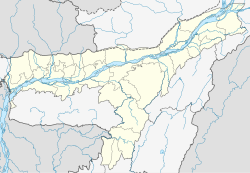Sarupathar
Sarupathar | |
|---|---|
Sub-Divisional Headquarter | |
| Coordinates: 26°11′39″N 93°51′58″E / 26.194053°N 93.866083°E | |
| Country | |
| State | Assam |
| District | Golaghat |
| Government | |
| • Body | Sarupathar Municipal Corporation |
| • SUB-DIVISIONAL OFFICER(Civil) | Dr P Uday Praveen IAS |
| Area | |
• Total | 3.5 km2 (1.4 sq mi) |
| Population (2011) | |
• Total | 10,827 |
| • Density | 3,100/km2 (8,000/sq mi) |
| Languages | |
| • Official | Assamese |
| Time zone | UTC+5:30 (IST) |
| PIN | 785601 |
| Area code | 03774 |
| Vehicle registration | AS-05 |
Sarupathar is a town and the Sub-Divisional headquarter of Dhansiri Sub-Division in Golaghat district in the state of Assam, India.
Demographics
As of 2011[update] India census,[1] Sarupathar had a population of 10,827. Males constitute 55% of the population and females 45%. Sarupathar has an average literacy rate of 60%, higher than the national average of 59.5%: male literacy is 84%, and female literacy is 77%. In Sarupathar, 11% of the population is under 6 years of age. A majority of Assamese and Bengali live here but also other communities like Nepali, Muslim, Marwari, Manipuri live here. The majority of Sarupathar's population are Hindu, but other religions like Islam, Buddhism, Christianity are also found here.
Government & Politics
Sarupathar is part of Kaliabor (Lok Sabha constituency). The current Member of Parliament representing Kaliabor is Gaurav Gogoi. The current Member of Legislative Assembly representing Sarupathar is Roselina Tirkey .[2]
Local Administration
The Sarupathar Municipal Corporation is responsible for the maintaining town's civic infrastructure as well as carrying out associated administrative duties. The Town Committee is constituted by elected members from each wards. The entire town has been divided into four wards, and one member is elected from each ward. One ward is reserved for women. The term is for a five-year duration after which elections are held once again.
Education
Under the 10+2 format, students attend primary and secondary schooling during the first ten years and then two years of higher secondary education, followed by three years at college for commerce or arts degrees.
Schools
There are three government high schools and several govt. Lower Primary(LP) and Middle English (ME) Schools in the heart of Sarupathar Town. The high schools are viz. Sarupathar HS School, Kalibari High School & Sarupathar Girls' High School. Sarupathar Higher Secondary School is the oldest school of Sarupathar. Founded by Jogeshwar Chetia in 1956 this school has produced excellent professionals and businessman.
The private English medium schools are Bolosing Memorial School (BMS), Dayanand Vidya Niketan (DVN), Don Bosco High School, Keshav Chandra Hazarika Memorial School (KCH) and Marvel Minds Academy. The only private assamese medium school in the town is Sankardev Sishu Niketan. Dayanand Vidya Niketan was founded by Mr. Shivaji Rai in the year 1990. Bolosing Memorial School was also founded by Mr. Shivaji Rai in the year 1993. Both DVN and BMS are among the most sought after schools in the town. Marvel Minds Academy, was established in the year 2016 and has emerged as an excellent educational institution at such an early phase. The other private schools like Don Bosco High School and KCH too has had a remarkable track record.
College
There are three colleges in Sarupathar Sarupathar College,Ideal Junior CollegeandSwahid Kushal Konwar Girls College The biggest and the oldest college is the Sarupathar College which was established in 1970. Sarupathar College, affiliated to Dibrugarh University, offers various courses in Commerce and Arts.It also has study centre of KKHSOU which offers various PG courses in distant modes.
References
- ^ "Census of India 2001: Data from the 2001 Census, including cities, villages and towns (Provisional)". Census Commission of India. Archived from the original on 16 June 2004. Retrieved 1 November 2008.
- ^ "List of Parliamentary & Assembly Constituencies" (PDF). Assam. Election Commission of India. Archived from the original (PDF) on 4 May 2006. Retrieved 6 October 2008.


